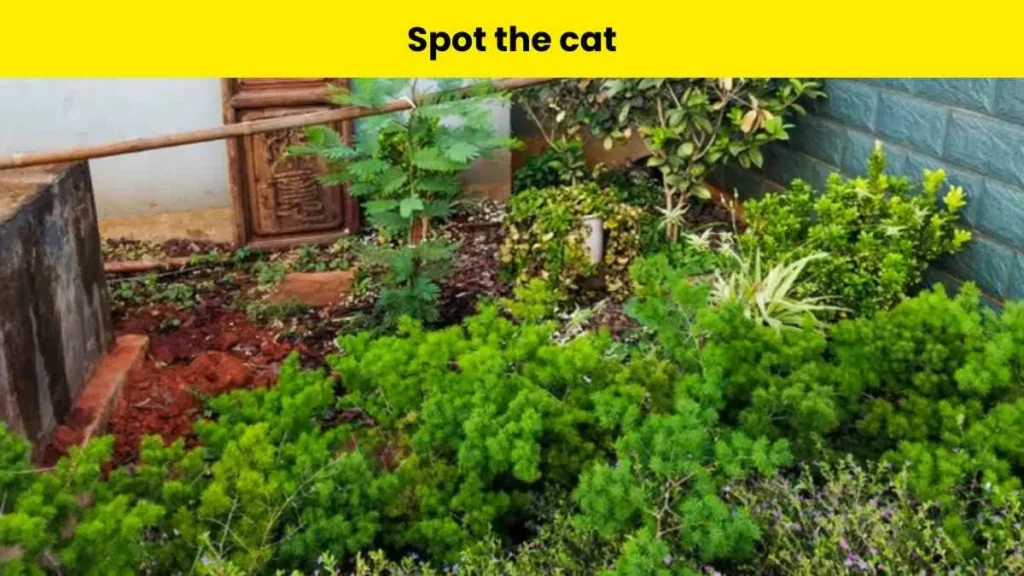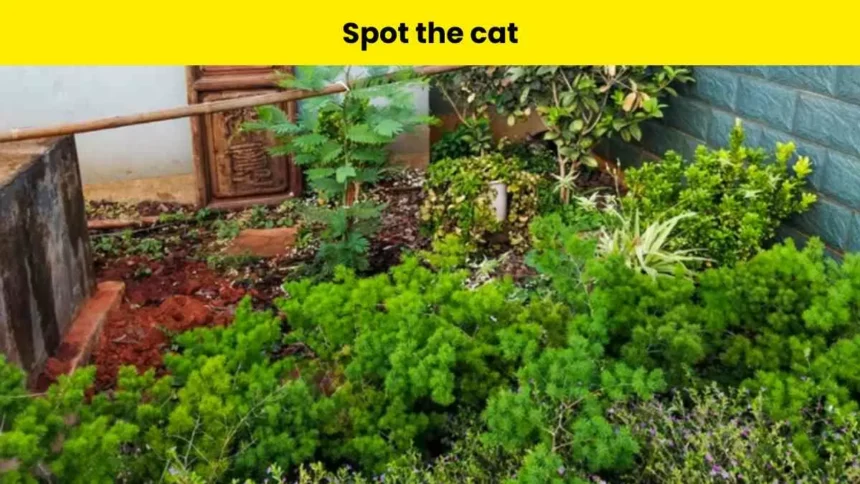Optical illusions have long fascinated humanity, offering glimpses into the intricate workings of our visual perception. They challenge our minds, teasing out the boundaries between reality and illusion.
One particularly captivating form of optical illusion is the challenge to spot hidden objects within complex images.
Among these challenges, the quest to spot a hidden cat in a garden within a mere 6 seconds stands as a testament to the power of visual perception and the complexities of our cognitive processes.
The Challenge:

Imagine yourself standing in the midst of a vibrant garden, filled with lush greenery and an array of colorful flowers.
Yet, amidst this serene scene, lies a hidden secret – a feline form cunningly concealed within the foliage.
Your task? To spot this elusive creature within the blink of an eye, within a mere 6 seconds.
The Challenge of Visual Perception:
At first glance, the task may seem simple. After all, how difficult can it be to locate a cat within a garden?
However, as we delve deeper into the nuances of visual perception, we begin to realize the intricacies involved in this seemingly straightforward challenge.
Our visual system is a marvel of biological engineering, capable of processing vast amounts of visual information in fractions of a second.
Yet, it is also prone to certain limitations and biases, which can influence our perception in unexpected ways.
Optical illusions exploit these quirks of perception, leading us to see things that may not necessarily align with reality.
The Garden Scene:
Let us dissect the elements of the garden scene where our elusive feline friend is hiding.
The lush green foliage provides ample camouflage, blending seamlessly with the cat’s coat.
The intricate patterns of light and shadow further obscure the cat’s presence, creating visual distractions that can confound even the keenest of observers.
Moreover, the garden itself is a cacophony of colors and textures, with flowers of varying shapes and sizes dotting the landscape.
This visual complexity adds another layer of challenge to the task, as our eyes must sift through the myriad details to uncover the hidden cat.
The Role of Attention:
In the realm of visual perception, attention plays a crucial role in guiding our focus towards relevant stimuli while filtering out distractions.
The challenge to spot the hidden cat within 6 seconds places a premium on our ability to allocate attention effectively, honing in on the salient features of the scene amidst a sea of visual information.
Research in cognitive psychology has shown that attention operates in both bottom-up and top-down fashion.
Bottom-up processes are driven by the inherent properties of stimuli, such as their color, motion, or contrast, which automatically capture our attention.
In contrast, top-down processes involve the deliberate allocation of attention based on our goals, expectations, and prior knowledge.
In the context of the optical illusion challenge, both bottom-up and top-down processes come into play.
The cat’s distinctive features may attract our attention in a bottom-up fashion, drawing our gaze towards its location within the garden.
Simultaneously, our top-down expectations of what a cat looks like and where it might hide guide our search, helping us navigate the visual landscape more efficiently.
The Power of Peripheral Vision:
Another factor that influences our ability to spot the hidden cat is the role of peripheral vision.
While our central vision is highly adept at processing fine details and colors, our peripheral vision excels at detecting motion and large-scale patterns.
In the context of the garden scene, our peripheral vision may pick up on subtle cues that hint at the cat’s presence, such as the flicker of a tail or the outline of its silhouette against the foliage.
However, relying solely on peripheral vision may also lead to false positives, where our brain interprets random patterns as meaningful stimuli.
This phenomenon, known as pareidolia, is a testament to the brain’s propensity to seek out familiar patterns even in the absence of clear evidence.
Thus, while peripheral vision can aid us in the search for the hidden cat, it must be supplemented by careful scrutiny of the entire scene to avoid misinterpretations.
Cognitive Strategies for Success:
As we embark on the challenge to spot the cat within 6 seconds, several cognitive strategies can enhance our chances of success.
First and foremost is the concept of “chunking,” wherein we break down the visual scene into smaller, more manageable chunks that can be processed sequentially.
By focusing our attention on specific regions of the garden, we can systematically search for the cat without becoming overwhelmed by the sheer complexity of the scene.
Additionally, employing saccadic eye movements can help us scan the garden rapidly, flitting from one point of interest to the next in search of the hidden cat.
Saccades are quick, jerky movements of the eyes that allow us to sample different parts of the visual scene within milliseconds.
By strategically directing our saccades towards areas where the cat is most likely to be hiding, we can optimize our search efficiency and maximize our chances of success.
Furthermore, leveraging our knowledge of cat behavior and anatomy can provide valuable clues as to where the cat may be lurking within the garden.
Cats are known for their stealthy nature and penchant for seeking out cozy hiding spots, such as beneath bushes or behind foliage.
By mentally simulating the cat’s perspective and anticipating its potential hiding spots, we can narrow down our search area and focus our attention where it is most likely to yield results.
The Neuroscience of Visual Perception:
Delving deeper into the underlying neural mechanisms of visual perception, we uncover a fascinating interplay of brain regions dedicated to processing visual information.
The primary visual cortex, located in the occipital lobe at the back of the brain, serves as the gateway through which visual stimuli are first received and processed.
From there, information is relayed to higher-order visual areas, such as the parietal and temporal lobes, which extract more complex features and associations from the visual scene.
These higher-order areas are responsible for integrating information from multiple sensory modalities, memory stores, and cognitive processes, allowing us to construct a coherent understanding of our surroundings.
In the context of the optical illusion challenge, the rapid processing of visual information within these neural circuits is essential for spotting the hidden cat within the allotted time frame.
Neural networks specialized for object recognition, pattern detection, and attentional control work in concert to analyze the garden scene, identify relevant features, and guide our gaze towards the elusive feline.
The Illusion of Certainty:
Despite our best efforts and cognitive strategies, the task of spotting the hidden cat within 6 seconds remains a formidable challenge.
Optical illusions have a way of confounding our expectations and defying our intuitions, reminding us of the fallibility of human perception.
Even when armed with knowledge of the cat’s likely hiding spots and equipped with keen visual acuity, there is no guarantee of success.
The very nature of optical illusions lies in their ability to deceive and beguile, leading us down perceptual rabbit holes where reality blurs with illusion.
Moreover, individual differences in visual processing, attentional capacity, and cognitive strategies further complicate the challenge.
What may be glaringly obvious to one observer may elude another entirely, highlighting the subjectivity inherent in our perception of the world.
Conclusion:
In the quest to spot the hidden cat within 6 seconds, we embark on a journey through the labyrinthine depths of visual perception.
Armed with the tools of attention, cognition, and neural processing, we navigate the intricate tapestry of the garden scene in search of our elusive quarry.
Yet, beyond the

